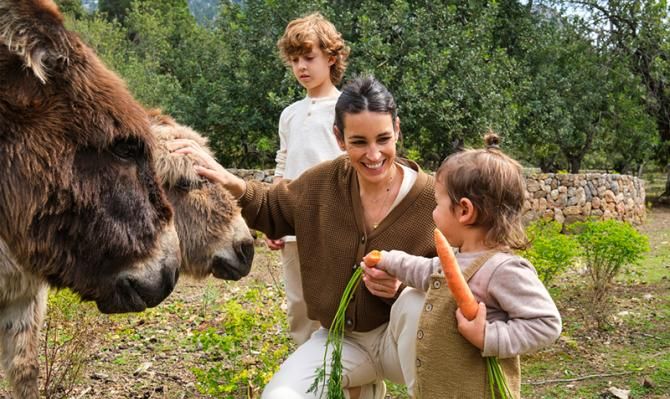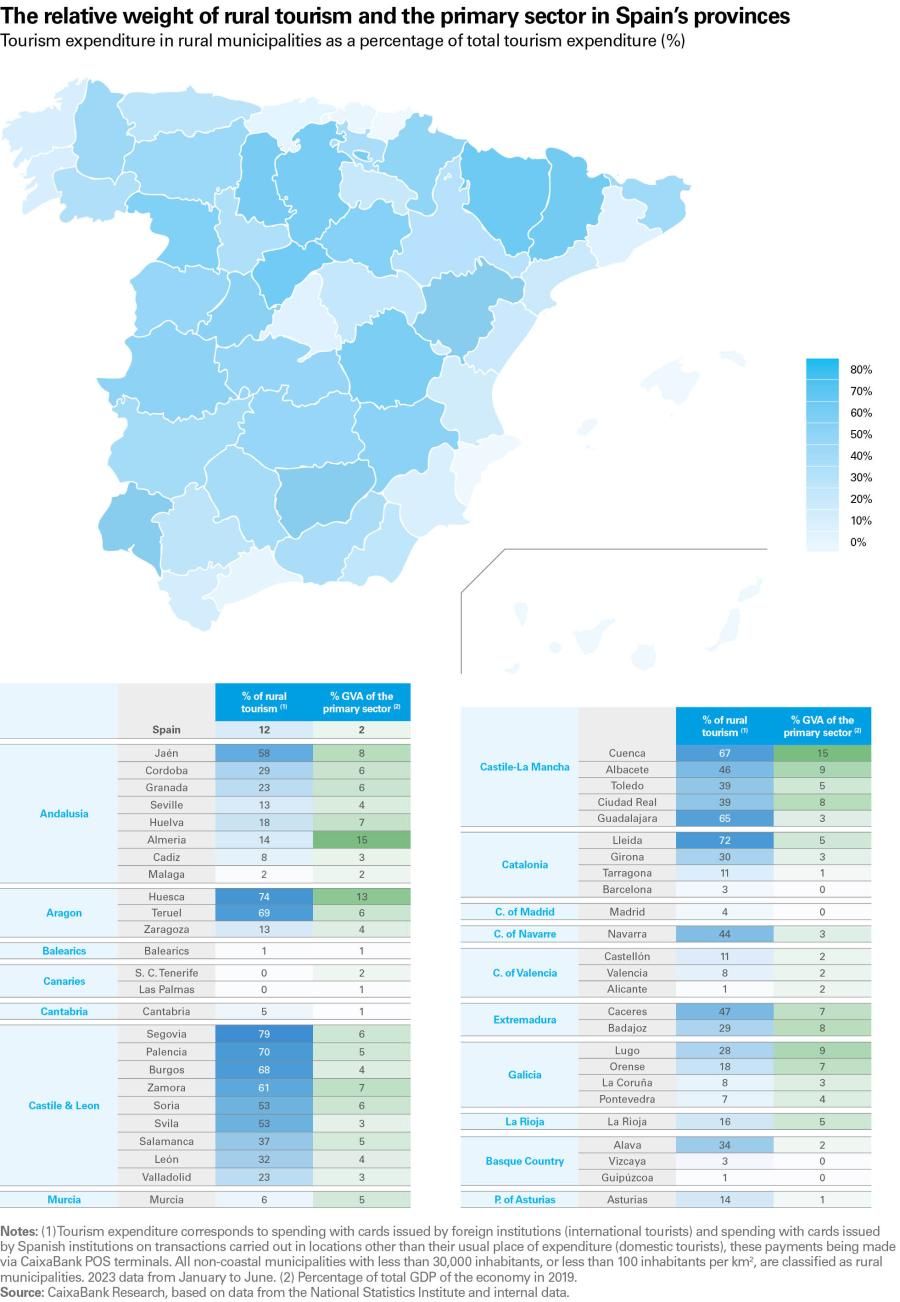The rise of rural tourism in Spain: an opportunity for rural development
In recent years, rural tourism has become increasingly important in Spain, opening up new avenues to diversify the sources of income for rural economies. In this article, based on internal CaixaBank data, we look at the upturn in the sector after the COVID-19 pandemic and its implications for the economic resilience of rural Spain and for the tourism industry, given its high level of sustainability both from the point of view of its impact on the environment and its greater geographic diversification and more limited seasonality compared to other, more traditional forms of tourism such as sun, sea and sand destinations.

Rural tourism: driving the economy of Spain’s agricultural areas
Rural tourism is playing an increasingly important role in boosting the economies of Spain’s most agricultural areas. According to CaixaBank’s internal data on card payments,28 rural tourism has gone from representing 10.9% of total tourism expenditure in 2019 to 11.9% in 2023,29 a relatively significant gain in share that indicates the stronger position of this type of tourism post-pandemic.
- 28Rural tourism expenditure corresponds to spending with cards issued by foreign institutions (international tourists) and spending with cards issued by Spanish institutions on transactions carried out in locations other than their usual place of expenditure (domestic tourists), these payments being made via CaixaBank POS terminals in rural municipalities. All non-coastal municipalities with less than 30,000 inhabitants, or less than 100 inhabitants per km2, are classified as rural municipalities.
- 29Data up to June 2023.

The above map shows that rural tourism is of great importance in the tourism mix of Spain’s inland provinces, regions where the primary sector also plays an important part in the economy. Such regions include Castile-La Mancha and Castile & Leon. For example, in Cuenca rural tourism accounts for 67% and the primary sector contributes 15% of the province’s GVA, while Segovia is the province with the highest rural tourism expenditure (79%). Both the primary sector and rural tourism are also relevant in Extremadura, Aragon and parts of Catalonia (Lleida and Girona) and the Basque Country (Alava).
Rural tourism contributes to diversifying the sources of income in agricultural areas and can also help to spread economic activity throughout the year
Tourism and agriculture are two very different economic activities but their sectors share certain characteristics: Spain enjoys an important competitive advantage in both, both produce considerable exports and help to balance Spain’s current account, and both tend to generate income on a relatively seasonal basis, which implies a high seasonality of employment in these sectors. However, rural tourism not only contributes to diversifying the sources of income in agricultural areas but can also help to spread economic activity throughout the year since the seasonal pattern of rural tourism does not coincide with that of agricultural production, as can be seen in the chart below. Although rural tourism is very seasonal, with 43.8% of its expenditure concentrated between June and September and a peak of 16% in August, the fact that it’s relatively more robust during the winter months makes it less seasonal than coastal tourism.30
- 3050.8% of expenditure in coastal municipalities is concentrated in the period from June to September while the seasonality in urban municipalities is less marked (37.3% of expenditure is concentrated in the period June-September).
The resilience and growth of rural tourism post-pandemic
The development of rural tourism is closely related to the COVID-19 pandemic. The chart below shows month-by-month expenditure on coastal, urban and rural tourism, benchmarked by the same month in 2019. During the pandemic, we can see that rural tourism proved to be much more resilient than urban and coastal tourism, with expenditure in summer 2020 reaching 80% of the level recorded in 2019 and surpassing this 2019 level as early as the second half of 2021. During the pandemic, tourists opted for less crowded destinations that enabled more outdoor activities and social distancing.
Despite the fact that the progress of rural tourism is linked to the pandemic, we can also see that, once the restrictions on people’s movements were relaxed, tourists have continued to choose this option. The growth in expenditure on rural tourism has outpaced that of coastal and urban tourism in each month of 2022 and 2023 (with data up to June), suggesting that the trend observed during the pandemic was not temporary but a reflection of a change in the preferences of tourists, who are now opting for nature-based holidays, undoubtedly influenced by the greater importance placed on environmental sustainability.
Domestic tourists are driving rural tourism
The contribution of international tourists to rural tourism is relatively moderate: between January and June 2023, foreigners accounted for 27% of rural tourism expenditure, which represented 3.2% of all tourism expenditure in Spain, a very similar percentage to the same period in 2019. Consequently, the growth in rural tourism between 2019 and 2023 can be attributed to an increase in spending by domestic tourists, an aspect that would be linked to the aforementioned change in preference of Spanish tourists brought about by the pandemic that has continued up to the last few months. In contrast, the breakdown of expenditure between international and domestic tourists is very different in coastal municipalities, one of the most traditional destinations for the tourism industry and which accounted for 62% of total expenditure in 2023. Foreigners play a predominant role in this figure, contributing close to 70% of tourism expenditure in such municipalities. Finally, urban tourist destinations accounted for 27% of total tourism expenditure during S1 2023 and foreign tourists accounted for around 40% of total urban expenditure.

The change in preference of domestic tourists in favour of rural tourism represents an opportunity for the economic development of rural areas and has great potential to boost the sustainability of the tourism industry
The sustainability of rural tourism
Two aspects stand out from a sustainability perspective: the potential for environmental sustainability and sustainability from the point of view of the geographic diversification of rural tourism.
Rural tourism is particularly sustainable in ecological terms. It’s intrinsically associated with nature and, in fact, an important proportion of this tourism takes place in or near protected areas. This increases environmental awareness among the population and, in turn, leads to stricter regulations to promote environmental conservation. But it’s important to note that it’s a two-way relationship between rural tourism and a preference for sustainability; a more environmentally aware public will probably choose more sustainable destinations. Therefore, with the growing importance of the ecological transition, an attractive range of rural tourism services and products is key for this public to continue choosing destinations in Spain.
Rural tourism also seems to be a sustainable option given the crowding problems faced by urban and coastal destinations. Rural tourism helps to distributes tourists over a larger area, spreading the burden on local infrastructure and services and easing the pressure on tighter housing markets. Economic benefits for rural communities can also help to mitigate the phenomenon of rural depopulation.
